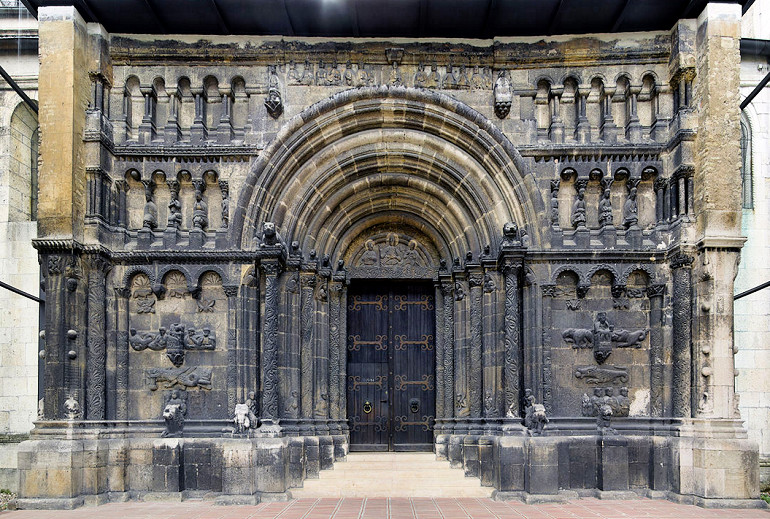
The former monastery church of St. Jacob (St. James) in Regensburg was built by Irish Benedictine monks in the 11th century. Since the Irish monks were popularly called Skoten, the
church is still called Schottenkirche today. After several alterations, the church, which still exists today, was completed before 1200. It is one of the main works of
Romanesque architecture in southern Germany. Irish stonemasons were still working in Regensburg in the 13th century.
The famous north portal of St. Jakob, known as the "Schottenportal", is one of the most important Romanesque architectural monuments in Germany.
Today the monastery serves as a seminary. On Sundays at 14:00 (from 1 April to 31 October) there are very interesting and recommendable guided tours through the church.
See Details for a visit

The towers of the Schottenkirche, seen from the Bismarkplatz

The Western Front

The nave with the famous Schottenportal (Scotts portal). To protect it from further destruction by harmful environmental influences (car exhaust fumes), it has been provided with a glass porch.
The almost thousand year old nave

Romanesque figure of Christ, on the left Mary, on the right John

The monk Rydan with the key and the doorbeam. This Romanesque sculpture is located to the right of the entrance gate (bulkhead portal) inside the church. The beam is exactly at the height of the right beam. Of course there is a legend about it.
The world-famous tartan portal with impressive pictures from the Middle Ages. Today there are several interpretations of this.

Detail from the Schottenportal
For further details, touch the tympanum and the figures left and right in the picture above
![]() with the mouse.
with the mouse.

In search of Gertrude:
When Gertrud von Supplinburg first came to Regensburg, the Scottish monastery already existed. She certainly got to know it.
When her second husband Heinrich Jasomirgott had to cede the duchy of Bavaria to her son (Heinrich the Lion) from her first marriage, Jasomirgott was enfeoffed with the Ostmark, which had been raised to the status of a duchy. Henry brought the 'Scottish monks' from Regensburg for a new monastery, which he had built in front of the newly elected capital Vienna. In the Viennese Scottish monastery is also the last resting place of the founder Heinrich Jasomirgott.
Gertrud is not buried in the Schottenkloster in Regensburg. Perhaps with second husband in the Schottenkloster in Vienna?









